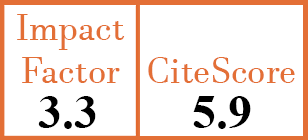Full Papers
Are the cutaneous manifestations in patients with primary antiphospholipid syndrome a marker for predicting lung manifestations?
M. Kontic1, L. Stojanovich2, M. Mijailović-Ivković3, M. Velinović4, J. Srnka5, M. Zdravkovic6
- Clinic for Pulmonology, Clinical Center of Serbia, and School of Medicine, University of Belgrade, Serbia.
- Internal medicine, “Bezanijska Kosa”, University Medical Center, Belgrade, Serbia.
- General Hospital Sabac, Serbia.
- Regional Medical Center “Južni Banat”, Pančevo, Serbia.
- General Hospital Sremska Mitrovica, Serbia.
- School of Medicine, University of Belgrade; and Internal Medicine, “Bezanijska Kosa”, University Medical Center, Belgrade, Serbia.
CER10326
2018 Vol.36, N°1
PI 0056, PF 0061
Full Papers
Free to view
(click on article PDF icon to read the article)
PMID: 28770705 [PubMed]
Received: 14/02/2017
Accepted : 18/04/2017
In Press: 17/07/2017
Published: 05/02/2018
Abstract
OBJECTIVES:
The aim of this study was to investigate association between pulmonary and skin manifestations in a large group of patients with primary antiphospholipid syndrome (PAPS) as well as their connection with antiphospholipid antibodies.
METHODS:
Our prospective study comprises of 390 patients with primary APS. Antiphospholipid antibody (aPL) analysis included detection of aCL (IgG/IgM), ß2GPI (IgG/IgM) and LA. Distinct pulmonary and skin associations were determined, as well as their associations with aPL.
RESULTS:
In PAPS patients the presence of LA was more common in PTE (p=0.005) and in pulmonary microthrombosis (p=0.003). We revealed statistical significance considering the presence of aCL IgM and pulmonary microthrombosis (p=0.05). Skin ulcerations correlated with positive titres aCL IgM and ß2 GPI IgM (p=0.03 and 0.04, respectively), while pseudovasculitis correlated with positive titres ß2 GPI IgM (p=0.02). PAPS patients were more more likely to develop pulmonary thromboembolisam if they had livedo reticularis (p=0.005), skin ulcerations (p=0.007), pseudovasculitic lesions (p=0.01), superficial cutaneous necrosis (p=0.005), and digital gangrene (p=0.02). Patients were also more prone to pulmonary microthrombosis if they already had livedo reticularis (p=0.03), skin ulcerations (p=0.007), pseudovasculitic lesions (p=0.05), superficial cutaneous necrosis (p=0.006), and digital gangrene (p=0.02).
CONCLUSIONS:
There is strong link between some pulmonary and skin manifestations in PAPS patients, suggesting complexity and evolutionary nature of APS. The presence of skin manifestations may be a high risk factor for several types of serious pulmonary manifestations in PAPS. Certain aPL types are associated with distinct pulmonary and skin manifestation, suggesting their predictive role.


